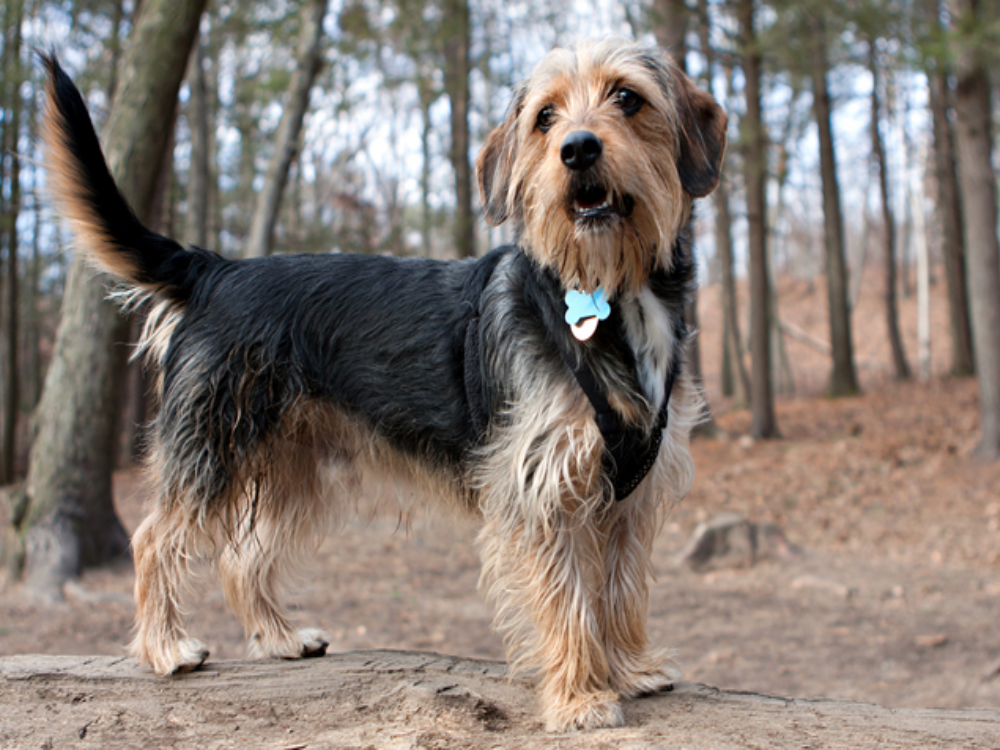
The beagle Yorkie mix is a cross between the Yorkshire Terrier (Yorkie) and the Beagle.
The Borkie dog is a mixed dog from breeding two purebred dogs, the Beagle and the Yorkshire Terrier. Therefore, she may also be called the Beagle/Yorkie Mix.
Sometimes the term Borkie refers to Yorkie/Bichon Frise cross, making sure you have the right dog! She is a small to medium-sized cross with a life span of 10 to 13 years and is quite vocal, loving, and social.
A Borkie is a lovely dog for owners looking for a small dog but one on the larger end of the scale. She is vocal, though, so it is not best for places with rules or fussy neighbours. However, she is loyal and affectionate and worth the extra attention you will need to pay to early socialization.
Where does the beagle Yorkie mix come from?
Yorkie Beagle Breed History Yorkie Beagles are designer dogs bred into being only a few short decades ago, during the 1990s.
They were bred to capture the most desirable traits from the Yorkshire Terrier and the Beagle, who were explicitly born to hunt. The Borkie, a renowned hunter like either of its parents, has inherited quite a few traits from both. It is heavily reflected in the Yorkie Beagle mindset, mannerisms, and looks.
For short, the Yorkshire Terrier, or Yorkie, was bred back in 1800 to hunt down rats and other vermin types. The Borkie retained that hunting instinct to a degree and chased smaller creatures from time to time.
On the other hand, beagles are much older breeds, and those pups were bred to help old English hunters track down birds.
Other Borkie possesses a similar zeal to Beagle and is similarly inclined to stick by the master’s sides as steadfast companions.
Are Yorkie Beagles are relative unknowns in the animal
Yorkie Beagles are relative unknowns in the animal, just like many other designer breeds. Their histories are still in the making, so to speak. But the relatively few people who have had the pleasure of owning a Borkie can attest to remarkable capacity for love, care, and companionship.
Borkies may not be well known for hunting dogs like either of their parents, but they are starting to gain traction as excellent family pets.
The Yorkshire Terrier

In England, in the mid 19th century, Scottish workers came looking for work in Yorkshire, bringing a dog called the Paisley Terrier or Clydesdale Terrier. This dog considers an excellent dog for catching rats and mice around the mills.
These dogs cross with other terriers, and in 1861 we see the first Yorkshire Terrier in a show called a broken-hair Scotch Terrier.
In 1870 they started to refer to Yorkshire Terriers because most of the breeding and development had happened.
In America, the earliest record of one being born there is in 1872.
As they are often referred to, the Yorkie is a confident and smart small dog with quite an intrepid spirit.
They can have a range of personalities; some are more cuddly, some are more active, and others are mischievous. Most Yorkies have in common, though, that if you spoil them too much, they can become quite a handful!
The Beagle

You can find Beagle dogs back in Roman times, but the actual Beagle we have now cannot be traced back that far. As with a lot of dogs, his history is a little confused. In the mid-1800s, you can see the starting of the Beagle we know today when bred for their hunting skills.
Today the Beagle has a gentle nature and will often make you laugh with their antics, but will also make you cry from their mischief! They are tricky things that are good at not listening or obeying you. He loves to follow a scent and is excellent with children – they get up their mischief together!
Beagles are also prone to escaping.
Natural problem solvers and incredibly bright, this breed is known to dig, climb, and squeeze its way out of homes and backyards.
Prospective owners should ensure their yards are secure and keep a watchful eye on their Beagle when going in and out of the house.
And because of Beagle’s strong prey drive, experts warn against letting this breed off-leash during walks. If you do, you risk your Beagle taking off after smaller animals and possibly putting himself in harm’s way, especially if you are walking him near busy roads or residential neighbourhoods.
What is beagle Yorkie mix Temperament & Behavior?
With their loyalty, patience, and affectionate nature, the borkie can be an ideal family dog, especially with those who can give them plenty of attention regularly.
They enjoy following you everywhere and love sleeping next to you to get a cuddle.
Beagle Yorkie mixes are active and playful, making excellent companions to children and being comfortable with other house pets.
As a social breed, they tend to find friends in anyone they encounter, making your visitors feel safe, which does not make them a good guard dog. However, that doesn’t make them a good guard dog, but they are prone to barking.
The borkies are curious dogs with a strong chasing instinct that often instigates them in following their ears and nose. These intelligent canines would readily perceive what you are expecting from them. Borkies do not enjoy the cold climate.
What does the Borkie Dog look like
beagle Yorkie mix is a small to medium-sized dog weighing 20 to 25 pounds and standing 12 to 15 inches tall. She has a round face, dark nose, black eyes, floppy ears, and Beagle’s chest. She has a coat that can be like either dog, long curly and silky.
Standard colours are black, grey, tan, white, and tri-colour.
Training and Exercise Needs
How actively does a beagle Yorkie mix need to be?
She is somewhat active and will need a couple of medium length walks a day. However, she is of a size where she can live happily in an apartment, and some of her indoor playtimes will be meet part of her exercise needs.
Access to a yard is unnecessary, but it would be a bonus for her to play in. The Borkie inherit the Beagle’s sense of smell, so she may tend to take off when she catches a scent and may also do the same to chase small animals.
What is a beagle Yorkie mix Dog Trainability?
Eager to learn, Borkies enjoy their training sessions and make for good little pupils. However, their downfall is their attention span, and they will become easily distracting from the task at hand, especially if outdoors.
Basic training should begin from a young age, and owners should reward appropriate behaviour with plenty of treats. It is not unheard of for poorly training and under-stimulating Borkies to develop vices, such as excessive barking.
Owners must work with them to ensure that doesn’t happen by providing them with a stable and consistent training program.
Living with a beagle Yorkie mix
How often should I groom A beagle Yorkie mix?
The Borkie tends to lean more towards the Yorkie in terms of the coat, so it sheds little and can be hypoallergenic. But some do take after the Beagle more, so the shedding goes up a bit, and she is not hypoallergenic.
Like the Yorkies, her coat will need trimming every couple of months or so at a groomer’s. While there, you can also have her nails clipped when they get too long. If you prefer to do it yourself, here are some useful tools.
Bathing is only needed to avoid drying out the natural oils in her skin. Brush it two to three times a week and give her ears a check and wipe once a week.
Her teeth should get brush two to three times a week. What is she like with children and other animals? With early socialization and training, she can be kid-friendly and dog friendly, and it can help curb her instincts to chase smaller pets. Teach the children how to play and touch dogs without scaring or hurting them too.
General information
The Borkies bark a lot and can have the Beagle howl, so if you live in an apartment with nose rules, this may be a problem. It will want to be fed at least twice a day, dividing 1½ to 2 cups of good quality dry dog food daily. She will need some extra care if you live in a freezing area.
Borkies Health
Dogs that generally enjoy good health, we need to be on the watch for a handful of health conditions that may be experienced throughout their lifetime:
Ear Infections
Due to their large and drooping ears, these dogs are more likely than others to develop chronic ear infections. Symptoms can include head shaking, ear scratching, and vocalization. Owners may notice that the skin inside the ear appears red and inflamed. In addition, there is a large amount of foul-smelling discharge within the ear canal.
When your borkie have an Infection, it should be treated as soon as they are present. Keeping canals dry at all times and cleaning ears can prevent the infection from setting in in the first place.
Tracheal Collapse
The support of the trachea (or windpipe) is cartilage. If this cartilage does not provide enough support, the airflow restricts the windpipe to collapse to some degree.
Dogs may suffer from shortness of breath and a chronic, dry cough. Most benefit from weight loss (if needed) and a body harness rather than a neck collar. For some, medications will offer relief from symptoms, while those more severely affected may require surgery.
Hypothyroidism
An underactive thyroid gland results in a circulating thyroid hormone level that is too low. The thyroid hormone is responsible for various body functions and causes many symptoms when it is not working. Hypothyroid dogs are often slow and sluggish.
They are typically overweight and find it hard to slim down. Affected dogs may also have a slow heart rate. Can find it hard to stay warm, sometimes displaying ‘heat-seeking behaviour around the home.
Thankfully, this hormonal condition can treat by replacing the thyroid hormone with tablets are taken each day. Dogs will require frequent check-ups and blood tests with the vet to confirm the disease.
